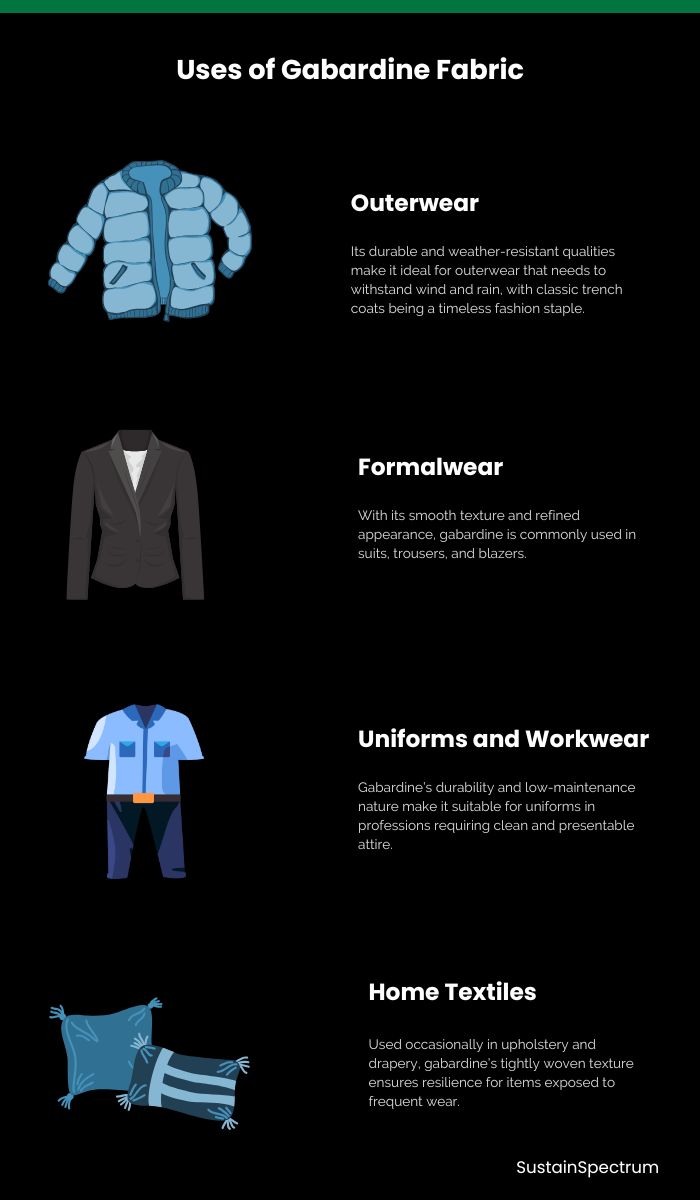Gabardine is a twill-weave fabric distinguished by its fine diagonal lines on one side and a smooth surface on the other. It is typically woven with worsted wool but can also be made from cotton, polyester, or blended fibers. Its closely woven structure makes gabardine both strong and resistant to wind and water, making it suitable for various types of outerwear and professional attire.
Characteristics of Gabardine Fabric
| Property | Description |
|---|---|
| Weave | Twill, creating visible diagonal lines |
| Texture | Smooth with a fine, tight weave |
| Durability | High resistance to wear, creasing, and tearing |
| Weight | Generally medium-weight but can vary |
| Weather Resistance | Offers natural resistance to wind and water |
| Breathability | Moderate, depending on fiber composition |
Composition of Gabardine
- Wool Gabardine: Traditional and high-end; offers natural warmth and moisture resistance.
- Cotton Gabardine: Slightly lighter, breathable, and often used for casualwear.
- Polyester Gabardine: Durable, more affordable, and resistant to wrinkling.
- Blended Gabardine: Wool-polyester or cotton-polyester blends, combining the qualities of both fibers for added versatility.
History of Gabardine
Gabardine was developed in the late 19th century by Thomas Burberry, founder of the Burberry fashion brand. He designed it as a robust, weatherproof fabric for outerwear, creating what he called “Burberry gabardine.”

The fabric was quickly adopted by explorers, aviators, and military personnel due to its durability and resistance to the elements. Gabardine has since maintained its popularity as a fashionable, functional fabric.
Uses of Gabardine Fabric

Gabardine is a top choice for outerwear like coats, trench coats, and jackets, thanks to its durability and weather resistance, ideal for standing up to wind and rain. The classic gabardine trench coat, for example, remains a timeless fashion staple. This fabric is also favored for formalwear, including suits, trousers, and blazers, where its smooth texture and elegant look make it perfect for professional and formal settings.
Wool gabardine, in particular, is prized for its refined drape and long-lasting quality. Gabardine’s resilience and easy maintenance also make it ideal for uniforms in roles requiring a neat, presentable look, like those of police, military, and corporate staff.
For casual clothing, lighter gabardine fabrics made from cotton or blends are popular for pants, skirts, and dresses, offering comfort with a polished look. While less common, gabardine also finds a place in home textiles, like upholstery and drapery, where its tightly woven texture and durability suit items exposed to frequent use.
Comparing Types of Gabardine Fabric
| Type | Characteristics | Best For |
|---|---|---|
| Wool Gabardine | Warm, high-quality, natural moisture resistance | Formal suits, coats |
| Cotton Gabardine | Lightweight, breathable, slightly less durable | Casual pants, light jackets |
| Polyester Gabardine | Affordable, wrinkle-resistant, weatherproof | Uniforms, workwear, trench coats |
| Blended Gabardine | Combines qualities of wool and polyester | Everyday wear, uniforms |
Advantages of Gabardine Fabric
Gabardine’s tight weave and high thread count make it highly durable, resisting wear, wrinkles, and stretching. Originally crafted to withstand wind and water, it’s perfect for outerwear and seasonal transitions. Its fine weave and smooth surface give it a professional, polished look, adding elegance to any garment. Gabardine also retains its shape well, making it an excellent choice for tailored clothing that needs to keep its form.
Disadvantages of Gabardine Fabric
Wool gabardine can sometimes feel less breathable than other fabrics, particularly in warm weather. It often requires dry cleaning, which can be both inconvenient and costly. Over time, wool gabardine may also develop pilling, especially in areas with frequent wear.
Gabardine Care and Maintenance
Proper care for gabardine ensures its longevity and maintains its appearance. The best care practices may vary depending on the fabric composition.
- Wool Gabardine: Dry clean only to avoid shrinkage and maintain fabric quality.
- Cotton Gabardine: Machine wash on a gentle cycle with cold water and air dry.
- Polyester Gabardine: Machine washable; tumble dry on low heat to reduce wrinkles.
Gabardine can crease, especially when stored improperly. Use a warm iron and press on the reverse side to avoid shine, or use a steamer to smooth out wrinkles without direct heat. Hang wool gabardine garments on padded hangers to maintain shape. For off-season storage, keep gabardine clothing in breathable garment bags to protect from dust and moths.
Sustainability and Alternatives to Gabardine Fabric
While wool gabardine is a natural fiber, cotton and polyester gabardine may not be as environmentally friendly due to water-intensive cotton production and non-biodegradable polyester. Alternatives for those seeking eco-friendly options include:
- Organic Cotton Gabardine: Made from sustainably grown cotton, reducing environmental impact.
- Recycled Polyester Gabardine: Repurposes existing materials, lessening plastic waste.
- Linen or Hemp Fabrics: Natural and biodegradable, though they lack gabardine’s distinctive twill structure.
Gabardine in Today’s Fashion
Gabardine’s legacy endures in modern fashion with its classic appeal and practical benefits. Brands like Burberry, Dior, and Prada often use gabardine in their collections, and its presence in both high fashion and casual wear remains strong. In addition to coats and suits, gabardine can also be found in contemporary streetwear and designer workwear, adapting to trends without sacrificing its signature durability.
Conclusion
Whether you’re looking for professional attire, a classic trench coat, or versatile pants, gabardine offers a balance of elegance and resilience. With proper care, gabardine garments can last for years, making it a worthwhile investment for anyone seeking long-lasting and sophisticated clothing options.
